
|
|
|
|
|
|
2026-2031
The Martian Moons Exploration probe collects and returns samples
Martian Moons Exploration (MMX) is a robotic space probe designed to bring back the first ever samples from Mars' largest moon, Phobos. It is developed by the Japanese Aerospace Exploration Agency (JAXA), with collaboration from NASA, ESA and CNES who provide scientific instruments. The U.S. contributes a neutron and gamma-ray spectrometer, while the European contribution includes a near-infrared spectrometer and expertise in flight dynamics to plan the mission's orbiting and landing manoeuvres.
Originally planned for 2024, JAXA delayed the mission until the next available launch window in 2026.* MMX arrives in 2027, landing and collecting around 10 g (0.35 oz) of samples from Phobos, along with conducting Deimos flyby observations and monitoring Mars' climate. It provides evidence to explain the origins of the Martian moons, while also yielding information useful to future crewed missions. In addition to its spectrometers, the spacecraft includes multiple cameras and a dust monitor. The samples are returned to Earth in 2031.*
2026-2030
The PLATO observatory is operational
PLAnetary Transits and Oscillations of stars (PLATO) was selected as the third medium-sized (M) mission in the European Space Agency's Cosmic Vision programme (the others being "Solar Orbiter" launched in 2017 and the Euclid Space Telescope launched in 2022). This observatory would include a payload of 34 separate telescopes and cameras, each comprised of four CCDs at 4,500 x 4,500 pixels resolution. It would scan up to a million stars, looking for truly Earth-like planets in sufficient detail to examine their atmospheres for signs of life.* In operation from 2026 until 2030,* at Earth-Sun Lagrangian point L2, the mission has the following objectives:
• Discover and characterise a large number of close-by exoplanetary systems, with a precision in the determination of the planet mass up to 10%, of planet radius of up to 2%, and of stellar age up to 10%.
• Detect Earth-sized planets in the habitable zone around solar-type stars
• Detect super-Earths in the habitable zone around solar-type stars
• Measure solar oscillations in the host stars of exoplanets
• Measure oscillations of classical pulsators
PLATO is aided by data from the Gaia mission launched in 2013, which provides many useful targets for subsequent follow-up observations.
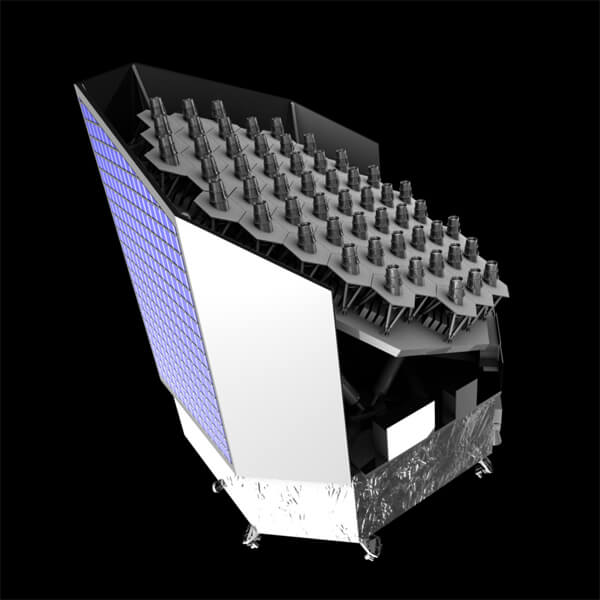
Credit: ESA
2026
First crewed flight of NASA's Orion spacecraft
In 2026,* NASA conducts a first human flight of the Orion Multi-Purpose Crew Vehicle (MPCV). This test, Artemis II, follows the uncrewed Artemis I in 2022 and the Earth-orbiting prototype in 2014. These missions form part of the agency's longer-term plan for sending humans to the Moon and Mars.
Artemis II is placed in high Earth orbit by a super heavy-lift rocket for two days. During this time, its crew performs checks of the life support systems and conducts an in-space rendezvous demonstration using the spent Interim Cryogenic Propulsion Stage (ICPS) as a target.
The spacecraft then fires its main engine to begin a translunar injection manoeuvre, sending it on a lunar free return trajectory. This involves a lunar flyby with a mission duration of 10 days – passing within 10,300 km (6,400 mi) of the Moon's surface – before returning to Earth. This mission is the first crewed spacecraft to travel beyond Earth orbit since Apollo 17 in 1972. The four-person crew includes a Canadian Space Agency (CSA) astronaut, the first Canadian to travel beyond low Earth orbit.
Artemis II is followed by Artemis III later in the decade, which delivers a human crew to the Moon's south polar region. Two astronauts, including the first woman on the lunar surface, spend roughly a week there before returning to Earth.
NASA's proposed timeline includes a total of 11 Artemis missions – running until at least 2035 – with potential for Orion to be used on Mars missions beyond then in combination with a Deep Space Habitat module for additional space and supplies.
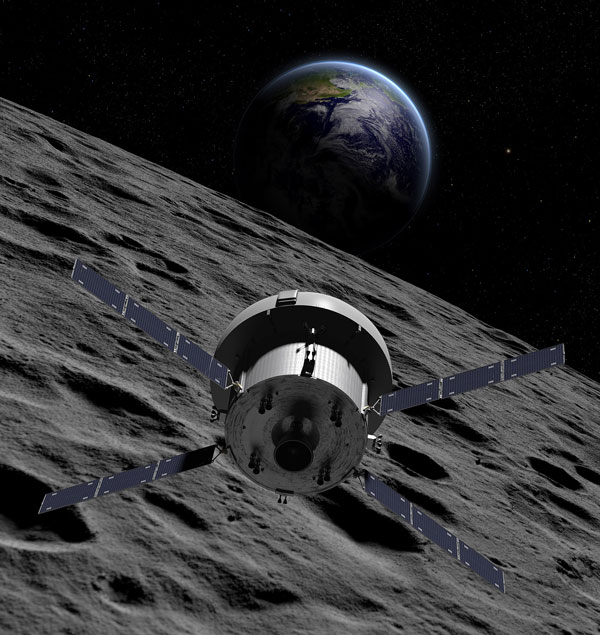
Artemis 2 in 2024. Credit: NASA
Italy hosts the Winter Olympics
The 2026 Winter Olympics take place from 6th February to 22nd February 2026, in the Italian cities of Milan and Cortina d'Ampezzo. Italy had beaten another joint bid from Swedish cities Stockholm–Åre, by 47–34 votes, at the 134th Session of the International Olympic Committee (IOC) held in Lausanne, Switzerland, on 24th June 2019. This marks the fourth time that the Olympic Games have been won by Italy, the first time they are hosted in Milan, and is also the first Olympic Games featuring two host cities in its name. It occurs on the 20th anniversary of the 2006 Winter Olympics in Turin and the 70th anniversary of the 1956 Winter Olympics in Cortina d'Ampezzo.

Construction of the Sagrada Família is complete
The Sagrada Família is a massive, privately-funded Roman Catholic church that has been under construction in Barcelona since 1882. Considered the masterwork of renowned Spanish architect Antoni Gaudí (1852–1926), the project's vast scale and idiosyncratic design have made it one of Spain's top tourist attractions, visited by millions of people each year. Construction of the building is finally completed this year, the 100th anniversary of Gaudí's death.*
Robotic hands matching human capabilities
As part of the on-going rise of consumer-level robotics, recent research in artificial intelligence and bio-inspired devices has reached a new plateau of possibilities. Modern robots are now able to fill an increasingly broad scope of roles in both home and work environments.* Easily one of the most important (and difficult) abilities for such machines is being able to recognise and interact with various physical objects. For simple or repetitive tasks, such as assembly line production, this knowledge was relatively straightforward, requiring simple programming and mechanical systems. However, the growing complexity of environments that commercial robots now have to encounter has driven research into more intricate and capable mechanisms.
As has often been the case, engineers turned to the human body itself to model both the form and function of new robot apparatuses. Since almost all robots must interact with and handle physical objects in some way, among the most commonly emulated body parts is the hand. Along with their associated computer programs and visual recognition software, robotic hands in the 2000s and 2010s had already boasted some impressive abilities. They could pick up delicate objects,* catch objects thrown to them,* make a range of gestures,* fold towels,* pour drinks and even prepare meals.* Despite this, the sheer dexterity and flexibility of the human hand and the practical limits of mechanical components prevented scientists from achieving a perfect recreation.
By the second half of the 2020s, however, the techniques involved have become sufficiently advanced to overcome most of the obstacles faced in previous decades. Around this time, some of the first robot hands equalling the capabilities of human hands are appearing in the laboratory.* Advances in nanotechnology,* miniaturisation and micro-electronics have allowed engineers to account for almost all of the subtle movements performed by a living biological hand. Graphene-based actuators converting electricity into motion, artificial skin, tactile sensors,* flexible electronics and various other features are employed to emulate the real thing. This has also been the result of an improved biological understanding of how humans manipulate objects.
AI programs, using precise visual perception software, are able to recognise countless physical objects and intelligently plan for how they can be manipulated. The robotic hand is therefore able to function autonomously and self-adjust to different objects based on texture, weight and shape. All of this can be accomplished in fluid, natural movements that are largely indistinguishable from those of a real hand. Though still in the trial stage, such systems will prove extremely useful in the development of human-like robots and androids. By the following decade, the subtle capabilities offered by robotic hands will allow machines to interact with humans and their environment in myriad new ways.*
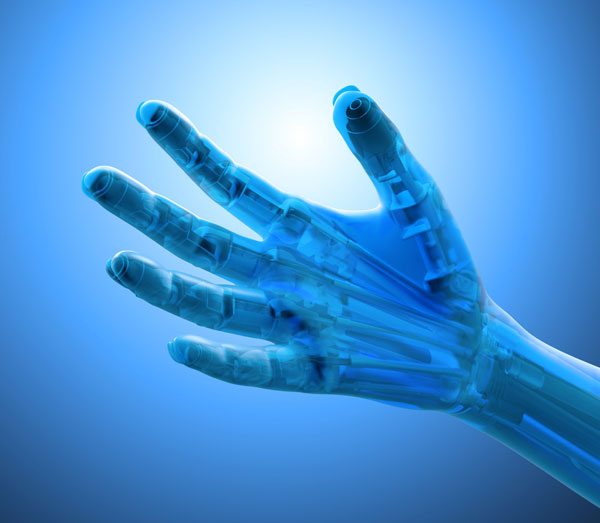
Grand Theft Auto VI is launched
In May 2026,* Rockstar Games launches Grand Theft Auto VI (GTA 6), arguably the most highly-anticipated video game of the last 10 years. Building upon the monumental success of GTA 5 – which became the second best-selling game of all time, behind only Minecraft – GTA 6 introduces groundbreaking new features that elevate the open-world genre to new heights.
Set in the reimagined Vice City (a fictionalised version of Miami), the game offers an expansive and immersive environment. Players can explore a dynamic world with unprecedented interactivity, which includes the ability to enter approximately 40% of buildings and experience advanced destruction physics in 60% of smaller structures. This level of detail, combined with a map surpassing GTA 5 in both size and diversity, creates a more realistic and engaging experience than even the likes of Red Dead Redemption 2, enhancing the series' hallmark of open-world freedom.
GTA 6 introduces two protagonists, Jason and Lucia, whose intertwined narratives provide a fresh perspective on the franchise's storytelling. As with previous titles in the series, gameplay revolves around a mix of high-stakes robberies, intense combat scenarios, strategic meetings, and a variety of missions that blend action, stealth, and exploration.
The launch of GTA 6 – initially on the PlayStation 5 and Xbox Series X/S – not only continues the legacy of its predecessor but also sets new standards in the gaming industry. With its innovative features, expansive world-building, and truly next-generation graphics, it once again redefines player expectations and solidifies Rockstar Games' position at the forefront of interactive entertainment.
The FIFA World Cup is hosted jointly in Canada, Mexico and the United States
The 23rd FIFA World Cup, held in the summer of 2026, is the first tournament hosted by more than two countries. It takes place in Canada, Mexico and the United States, who won the rights to host the contest at the FIFA Congress in Moscow on 13th June 2018, beating a rival bid from Morocco. The 2026 tournament is the biggest World Cup ever held, after FIFA approved an expansion from 32 teams to 48. A total of 80 matches are played – 60 in the US (including all eight matches from the quarter-finals onward), while Canada and Mexico host 10 matches each. The final takes place at the 85,000-capacity MetLife Stadium in East Rutherford, New Jersey.*

United States Semiquincentennial
4th July 2026 is the 250th anniversary of the United States Declaration of Independence in 1776. Festivities are scheduled to mark various events leading up to the anniversary date.
In 2016, Congress established the U.S. Semiquincentennial Commission, to encourage Americans to remember the past, celebrate the present, and look forward to a promising future. It aimed to orchestrate "the largest and most inclusive celebration in [the United States'] history."
The America250 Foundation, a non-profit partner of the Semiquincentennial Commission, launched a website to invite people – especially younger Americans who may not have access to traditional channels like voting or legislation – to share their vision for the next 250 years.*
As part of the anniversary, the government issues commemorative coins and postage stamps, including a series of five designs for the quarter – one of which depicts women's contributions to independence. Appropriately named naval vessels are also commissioned, while renovations and overhauls are carried out on various old buildings.
Events are held in locations of historical importance, with a focus on Boston, Charleston in South Carolina, New York, and Philadelphia. Battle re-enactments are performed in South Carolina, while a time capsule is buried in Philadelphia with its unearthing scheduled for 4th July 2276. The Semiquincentennial follows the Bicentennial of 1976 and is, itself, followed by the Tricentennial of 4th July 2076.
A quantum computer with 10,000+ qubits
This year sees the deployment of the first quantum computer to break the 10,000-qubit barrier.* Quantum computers are a relatively new and emerging alternative to traditional or "classical" computing, able to perform calculations of truly astronomical size and complexity. These numbers are many orders of magnitude higher than allowed by classical computing and would otherwise take billions of years for even the world's fastest supercomputers to work with.
Quantum computers achieve this feat by using quantum bits (qubits), the quantum equivalent of bits, which take advantage of a strange physical phenomenon known as superposition. Unlike the much simpler bits of classical computing, which are limited to binary states of either one (1) or zero (0), qubits can have multiple values simultaneously. By combining more and more qubits together, this creates an exponential cascade of branching possibilities, allowing countless solutions to be explored in parallel.
To maintain the delicate state of superposition, however, quantum computers must be kept under extreme conditions. This includes operating them within environments that are meticulously isolated from all forms of external interference, such as electromagnetic fields, vibrations, and temperature fluctuations. Specifically, these machines often require cooling to near absolute zero (-273.15°C or -459.67°F), the point at which atomic activity nearly ceases, to keep the integrity of the qubits' quantum states. Such conditions are critical to prevent decoherence, a process where the quantum states of the qubits are disrupted by the environment and lose their quantum properties, effectively rendering the calculation process ineffective.
For the first two decades of the 21st century, progress in boosting qubit numbers had been somewhat slow, in part due to the difficulty in preserving the coherence needed for superposition. But new techniques developed in the 2020s enabled quantum computing to reach an inflection point, with a rapid scaling up. IBM, for example, announced a 127-qubit processor called "Eagle" in 2021, followed soon afterwards by a 256-qubit device from Boston-based startup QuEra and even larger systems over the next few years. IBM debuted "Condor", its first processor to feature 1,000+ qubits, at the end of 2023.
These efforts are dwarfed by a 10,000+ qubit machine developed in 2026, the most powerful quantum computer ever built. The order of magnitude increase in qubit count is accompanied by 100 logical qubits. These are error-corrected qubits with fidelities exceeding physical qubits. Unlike their physical counterparts, which are individual qubits prone to errors from decoherence and other quantum noise, logical qubits are formed by encoding the quantum information of whole clusters of physical qubits into a single, fault-tolerant unit.
By grouping multiple physical qubits to form one logical qubit, more complex and lengthy calculations are possible with a greatly reduced error rate. The 100 logical qubits of this new machine are stable and reliable enough to solve real-world problems with unprecedented precision and efficiency, beyond the reach of classical computers and the earlier generations of quantum machines. This will soon lead to the discovery of new drugs, chemicals, and materials, for example, while transforming cryptography and improving the accuracy of models and simulations in fields such as climate change.
Until recently, the number of physical qubits had been the prime consideration for evaluating a quantum computer's performance. But with deep logical circuits demonstrated by this machine, alongside rival efforts of this time, physical qubits are becoming less important, with attention and focus now increasingly shifted to logical, error-corrected qubits.*
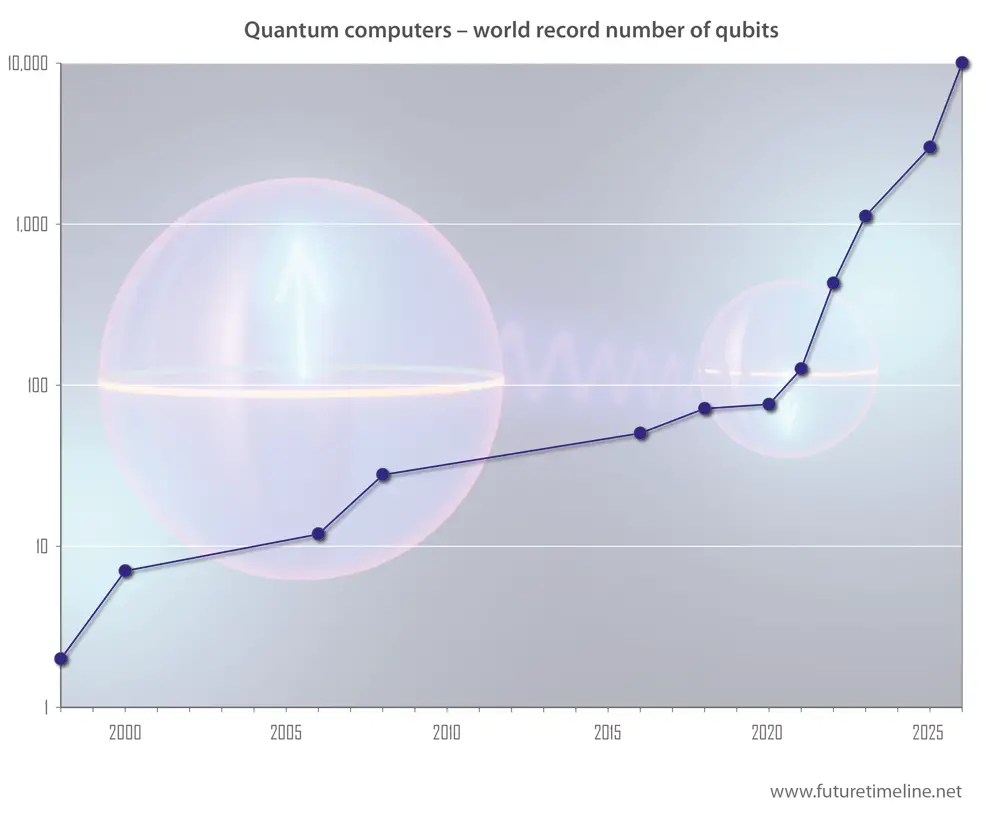
50TB hard drives
During the 2010s, solid state drives (SSDs) became the preferred choice for running computer operating systems and applications, due to their much greater speed than traditional spinning hard drives. However, the latter still had a role to play in archiving/backups and general storage. As such, they did not disappear and continued to form a part of computing ecosystems. Ongoing research and development led to huge capacities, with 20 terabytes (TB) emerging by the start of the next decade, based on shingled magnetic recording (SMR) technology.
An even greater innovation – heat assisted magnetic recording (HAMR) – boosted capacities still further. This technology involved tiny spots on the drive platter being heated to 450°C (842°F) and then cooled back down to room temperature in less than a nanosecond.* During this process, the spots would become more receptive to magnetic effects, allowing data to be written to much smaller spaces than with conventional magnetic recording (CMR). Additionally, new drives with multiple actuators enabled the vast volumes of data to be read at speeds matching or exceeding current HDDs, making them practical for everyday use.
Initially starting with around 20TB, these new HAMR drives quickly expanded in capacity over the next several years, reaching 50TB by 2026.* Although the gap is closing in terms of worldwide byte shipments, conventional hard drives continue to lead over SSDs for some time to come, thanks to their affordability and greater capacities. The global "datasphere", or the amount of digital data worldwide, has increased from 33 zettabytes in 2018 to over 200 zettabytes by 2026 and continues to grow exponentially.*
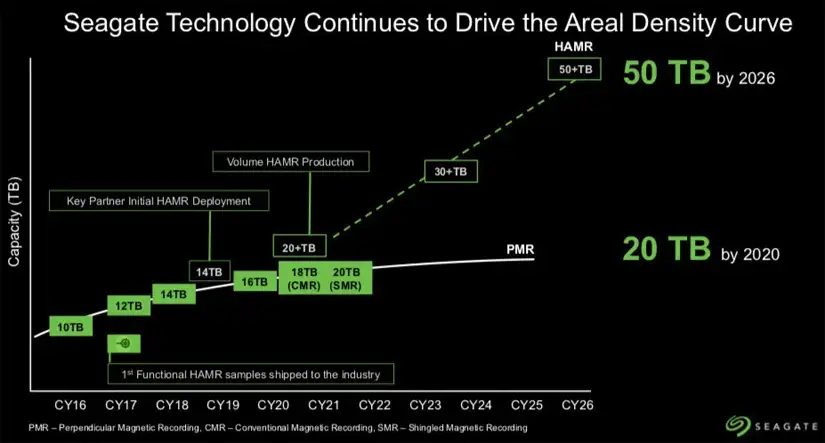
BepiColombo arrives in orbit around Mercury
BepiColombo is a joint mission between the European and Japanese space agencies. It is only the third mission to study Mercury at close range and only the second to enter into orbit around the planet. Consisting of a rocket component and two science probes, the mission performs a total of nine flybys around Earth, Venus and Mercury before orbital insertion in November 2026.* It is the most comprehensive on-location study of Mercury ever performed, with 12 specific objectives:
- What can be learned from Mercury about the composition of the solar nebula and the formation of the planetary system?
- Why is Mercury's normalised density markedly higher than that of all other terrestrial planets, Moon included?
- Is the core of Mercury liquid or solid?
- Is Mercury tectonically active today?
- Why does such a small planet possess an intrinsic magnetic field, while Venus, Mars and the Moon do not have any?
- Why do spectroscopic observations not reveal the presence of any iron, while this element is supposedly the major constituent of Mercury?
- Do the permanently shadowed craters of the polar regions contain sulphur or water ice?
- Is the unseen hemisphere of Mercury markedly different from that imaged by Mariner 10?
- What are the production mechanisms of the exosphere?
- In the absence of any ionosphere, how does the magnetic field interact with the solar wind?
- Is Mercury's magnetised environment characterised by features reminiscent of aurorae, radiation belts and magnetospheric substorms observed at Earth?
- Since the advance of Mercury's perihelion was explained in terms of space-time curvature, can we take advantage of the proximity of the Sun to test general relativity with improved accuracy?
The European contribution, Mercury Planetary Orbiter (MPO), studies the surface and internal composition, while the Japanese probe, known as the Mercury Magnetosphere Orbiter (MMO), analyses the magnetosphere and atmosphere. A new form of ion engine is used for the propulsion system. BepiColombo was originally planned for a 2014 launch with 2020 arrival at Mercury, but faced a number of delays. The mission concludes in 2029.
Europe's first successful vertical rocket launch into space
In 2026, SaxaVord Spaceport in the Shetland Islands becomes the site of Europe's first successful vertical rocket launch to orbit. This milestone marks a new chapter in the continent's aerospace ambitions, since previous European rocket missions have relied on French Guiana or suborbital flights elsewhere.
Two key players achieve success at SaxaVord, located on the remote island of Unst, one of the most northerly places in Scotland. The UK startup Orbex launches a small-lift rocket known as Prime. This two-stage vehicle stands 19 m (62 ft) in height, with a payload capacity of 180 kg (400 lb). After reaching a standard 500 km Sun-synchronous orbit, it deploys a cluster of cubesats. Meanwhile, German company Rocket Factory Augsburg conducts the maiden flight of its larger RFA ONE rocket, which stands 30 m (100 ft) tall and can deliver up to 1,300 kg (2,866 lb) to orbit in three stages. Together, these missions demonstrate that European domestic infrastructure can compete with the world's leading launch facilities.
SaxaVord's strategic position, with open sea in multiple directions, makes it ideal for launching payloads to polar and Sun-synchronous orbits. The spaceport's construction began several years earlier and had to overcome local weather constraints, environmental assessments, and the logistical hurdles of building complex aerospace infrastructure in such a remote location. Operators designed the pad to accommodate a new generation of small and medium-sized rockets, with the potential for as many as 30 launches each year, carrying satellites to track everything from climate data to maritime traffic.
The original 2025 target slipped. Regulators and site operators took longer than anticipated to finalise licensing and range procedures, while launch providers ran into the usual hurdles of a first-of-its-kind programme: engine qualification, vehicle integration, and the sequencing of ground tests. Orbex also refined its plans around SaxaVord and aligned its schedule with pad readiness, while Rocket Factory Augsburg focused on completing key test milestones before committing to a first orbital attempt. These factors collectively pushed the schedule into 2026.*
British and European leaders hail the achievement as a significant step forward for the region's nascent private space sector, which seeks to establish itself alongside more mature industries in the US, China, and Russia. The successful flight from SaxaVord adds momentum to other planned spaceports in Scotland and Norway, signalling Europe's intent to diversify away from a single equatorial location in French Guiana.

Credit: SaxaVord UK/PA
Hydrogen-based steelmaking reaches industrial scale
Hydrogen-based steel production is now advancing beyond pilot and early demonstration projects into industrial-scale deployment, as companies bring the first commercial greenfield facilities and other first-of-a-kind plants into operation. Together, these developments mark a significant step toward decarbonising one of the world's most carbon-intensive industries.
In Boden, northern Sweden, Stegra is building what it describes as the world's first large-scale, fully integrated greenfield steel plant designed from the outset to operate using green hydrogen rather than coal. Scheduled to begin production in 2026,* it uses renewable electricity to power large electrolysers that generate hydrogen for direct iron reduction, followed by steelmaking in electric arc furnaces.* Compared with conventional blast furnace routes, this process reduces carbon dioxide emissions from iron reduction by more than 95%, with overall emissions falling by 80–90% relative to traditional integrated steel plants.
Stegra, founded in 2020, had originally been named H2 Green Steel before rebranding itself. The company secured €6.5 billion in financing, which included over €300 million from the European Investment Bank, along with permits for a large greenfield development aimed explicitly at industrial-scale output rather than demonstration volumes. Construction began in 2022, with major civil works and installation of core process units progressing over the next few years. Long-term offtake agreements with European customers in sectors such as automotive and construction support the project, positioning the Boden plant as one of the first explicitly commercial hydrogen-based steelmaking facilities.
Alongside this greenfield approach, another initiative called HYBRIT (Hydrogen Breakthrough Ironmaking Technology) – also in Sweden – continues to develop hydrogen-based steelmaking through pilot and demonstration projects focused on replacing coal in existing supply chains. By the mid-2020s, HYBRIT's pilot plant in Luleå had produced more than 5,000 tonnes of hydrogen-reduced sponge iron, achieving metallisation levels of 99% and demonstrating improved handling and aging characteristics compared with blast furnace iron. These results validated hydrogen direct reduction under real operating conditions and laid the groundwork for larger-scale deployment.
In 2026, HYBRIT moves into a new phase as a first-of-a-kind plant in Gällivare, Sweden, is scheduled to begin operations.* This facility aims to produce around 1.2 million tonnes of hydrogen-reduced sponge iron per year once fully ramped, supported by a large electrolyser with a capacity in the region of 500 MW. Although the project retains its demonstration status, it operates at an industrial scale and aims to supply fossil-free iron to downstream electric arc furnaces, where it is then melted and converted into finished steel. This enables the gradual replacement of coal-based iron in the operations of global steelmaker SSAB, among other companies.
Looking toward the end of the decade, both initiatives outline major expansion plans. Stegra targets annual production of 5 million tonnes of green steel by 2030, while HYBRIT plans to scale hydrogen-reduced sponge iron output at Gällivare to about 2.7 million tonnes per year by the same date. Together, these trajectories represent the opening phase of a much broader transition, as hydrogen-based steelmaking begins to move from early industrial deployment toward wider commercial adoption in countries around the world.

« 2025 |
⇡ Back to top ⇡ |
2027 » |
If you enjoy our content, please consider sharing it:
References
1 Japan to Delay Mars Moon Exploration by 2 Years to 2026, The Japan News:
https://japannews.yomiuri.co.jp/science-nature/science/20231206-154061/
Accessed 21st January 2024.
2 MMX - Martian Moons eXploration, JAXA:
https://www.mmx.jaxa.jp/en/
Accessed 21st January 2024.
3 European Space Agency picks Plato planet-hunting mission, BBC:
http://www.bbc.co.uk/news/science-environment-26267918
Accessed 20th February 2014.
4 PLATO spacecraft to find new Earth-like exoplanets, PhysOrg:
https://phys.org/news/2017-06-plato-spacecraft-earth-like-exoplanets.html
Accessed 26th May 2018.
5 Artemis II, Wikipedia:
https://en.wikipedia.org/wiki/Artemis_II
Accessed 26th December 2024.
6 Sagrada
Família, Wikipedia:
http://en.wikipedia.org/wiki/Sagrada_Fam%C3%ADlia
Accessed 15th August 2010.
7 "Researchers predict that within 10 to 15 years, personal robots will become more commonplace, helping people keep their homes safe and perform household chores."
Robots predicted to join family in home or serve in public setting, TribLive:
http://triblive.com/business/headlines/3234427-74/robots-robot-robotics
Accessed 17th February 2013.
8 Egg Pick Up, YouTube:
http://www.youtube.com/watch?v=Fm96p6ygBmc
Accessed 17th February 2013.
9 Disney teaches a humanoid robot to play catch and juggle balls, Future Timeline Blog:
https://www.futuretimeline.net/blog/2012/11/24-2.htm
Accessed 17th February 2013.
10 Robot hand is unbeatable against a human opponent, Future Timeline Blog:
https://www.futuretimeline.net/blog/2012/06/27.htm
Accessed 17th February 2013.
11 See 2010.
12 CIROS, the salad-making robot, Future Timeline Blog:
https://www.futuretimeline.net/blog/2012/11/3.htm
Accessed 17th February 2013.
13 Article from 2011: "It will take around 15 years of research into these areas to build a robotic hand that is able to perform certain complex tasks with a level of precision, autonomy and dexterity that is similar to that of a human hand," predicts Professor Abderrahim.
See Scientists Developing Robotic Hand of the Future, Science Daily:
http://www.sciencedaily.com/releases/2011/06/110629083237.htm
Accessed 17th February 2013.
14 Thousands of nano-machines mimic human muscle, Future Timeline Blog:
https://www.futuretimeline.net/blog/2012/10/23.htm
Accessed 17th February 2013.
15 Robots that can touch and feel?, Future Timeline Blog:
https://www.futuretimeline.net/blog/2012/06/24.htm
Accessed 17th February 2013.
16 See 2034.
17 Grand Theft Auto 6 delayed until May 2026, BBC News:
https://www.bbc.co.uk/news/articles/cjew84ev3yyo
Accessed 9th October 2025.
18 World Cup 2026: Canada, US & Mexico joint bid wins right to host tournament, BBC:
https://www.bbc.co.uk/sport/football/44464913
Accessed 13th June 2018.
19 What is your wish for America's future?, My Wish For U.S.:
https://www.mywishforus.com/
Accessed 28th May 2022.
20 QuEra Computing Releases a Groundbreaking Roadmap for Advanced Error-Corrected Quantum Computers, Pioneering the Next Frontier in Quantum Innovation, QuEra:
https://www.quera.com/press-releases/quera-computing
Accessed 10th February 2024.
21 Error-Corrected Computers, QuEra:
https://www.quera.com/qec
Accessed 10th February 2024.
22 HAMR | Creating the Future, YouTube:
https://www.youtube.com/watch?v=aUHAd36BDTc
Accessed 9th December 2019.
23 Seagate is planning 50TB drives for 2026, The Tech Report:
https://techreport.com/news/3466913/seagate-50tb-hard-drive-roadmap/
Accessed 9th December 2019.
24 Are Hard Drives DISAPPEARING?, YouTube:
https://www.youtube.com/watch?v=7Ue0J-4qxDM
Accessed 9th December 2019.
25 BepiColombo, Wikipedia:
https://en.wikipedia.org/wiki/BepiColombo
Accessed 26th December 2024.
26 Orbex launch from Unst now expected in 2026, Shetland News:
https://www.shetnews.co.uk/2025/06/26/orbex-launch-unst-now-expected/
Accessed 3rd January 2026.
27 "Stegra's first steel production lines will go live in 2026 using recycled steel scrap as raw material, with green hydrogen-based iron and steelmaking beginning shortly thereafter..."
See Stegra's green hydrogen plant takes shape in Boden, Stegra:
https://stegra.com/news-and-stories/green-hydrogen-plant-takes-shape
Accessed 5th January 2026.
28 €3.5 billion "green steel" project to go ahead, Future Timeline Blog:
https://futuretimeline.net/blog/2022/11/4-green-steel-future-technology.htm
Accessed 5th January 2026.
29 Goodbye, Coal! This Project Makes Steel With Green Hydrogen, SNEC H2+:
https://www.snec-h2.com/article/goodbye-coal-this-project-makes-steel-with-green-hydrogen
Accessed 5th January 2026.
![[+]](https://www.futuretimeline.net/images/buttons/expand-symbol.gif)






